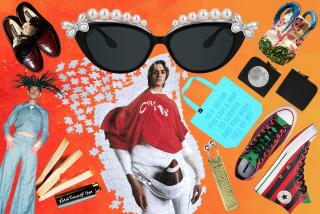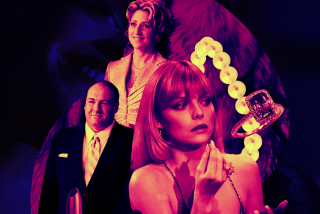L.A. labels Rock & Republic, William Rast at New York Fashion Week.
Two Los Angeles-based lines that showed during New York Fashion Week provided an interesting contrast in brand evolution (or de-evolution, depending on your take).
Rock & Republic’s Spring 2009 show in the Bryant Park tents on a Saturday night was titled “Redemption,” but “Dirty Sexy Money” was more like it. Shown against a backdrop of black walls on a white catwalk framed in fluorescent lights, the men’s and women’s collections were a mostly black-and-white affair full of the kind of ultra-short dresses and skin-tight trousers that would make a hooker blush.
From the models nearly stumbling on the high-gloss runway in killer stilettos to dresses with a bar-code pattern (called “show your i.d.”), the collection was full of creepy, woman-objectifying references that seemed innocuous at first glance but together formed a kind of misogynistic fantasy wardrobe. Ruched and ruffled off-the-shoulder dresses evoked a feeling of violently ripped clothes, and the black finish on one white skirt in particular looked as if the model wearing it had been backed over with a truck tire.
Rock ‘n’ roll? I suppose. Edgy? Sure. Sexy? In a restraining-order kind of way. But it’s also a step back from last season’s film noir-inspired collection that included floor-length gowns, knee-length dresses and a touch of class. Perhaps that’s because Los Angeles designer David Cardona, who had just been hired as vice president of design in December 2007, has quietly left the company. A Rock & Republic representative would say only that the designer “is no longer with the company,” and Cardona declined comment beyond saying he was with the company for a total of 10 months.
It was exactly the opposite scenario at the William Rast line’s New York runway debut less than 24 hours later at the Roseland Ballroom. The room had been turned into a folksy faux-rustic Tennessee tableaux complete with wooden benches, washtubs full of iced-down beer and a tin-roofed shotgun shack at the top of the catwalk.
The line -- launched by childhood friends Justin Timberlake and Trace Ayala with L.A.-based People’s Liberation in 2005 -- stood out because Timberlake seemed to chafe, at first, at the notion of using his celebrity status to sell the Hollywood-by-way-of-Tennessee collection, preferring that the line succeed or fail on its own merits. In December 2007, with the label failing to gain traction, they tapped Swedish husband-and-wife designers Marcella and Johan Lindeberg (he’s the namesake founder of the J. Lindeberg golf-inspired sportswear line) to help rejigger the line.
Spring 2009, the second season to bear the Lindebergs’ influence, finds the denim-based line shucking its good-old-boy flag and scroll-clutching eagle designs; chunky, yarn-embroidery embellishments; foil screen-printed T-shirts; and nylon windbreakers for a more edgy bad-boy feel that includes skulls, military details and oil-stained jeans that evoke a hard-working grease-monkey aesthetic. (Even the logo has undergone a makeover-- instead of an intricate design that looked like Roman numerals or Greek columns, it is now just three simple lines forming a modified chevron design.)
One of the last songs to accompany the runway show was the Johnny Cash version of Depeche Mode’s “Personal Jesus,” a song burly, bearded producer Rick Rubin had brought to Cash’s attention and one that gave new dimension to the singer’s already long and storied musical career. When the Lindebergs joined Justin and Trace on stage for a bow, Johan emerged sporting a wild Rubinesque beard, which hammered it all home. In a bid to be taken seriously in the world of fashion, one of the biggest pop stars on the planet sought out a sartorial savior of sorts.
And Michael Ball, who has leveraged the cache of his Rock & Republic label into a full-blown rock star lifestyle with ego to match, seemed to be doing the same thing. The only difference is, he found his inspiration no further than the other side of the mirror.
More to Read
Sign up for our L.A. Times Plants newsletter
At the start of each month, get a roundup of upcoming plant-related activities and events in Southern California, along with links to tips and articles you may have missed.
You may occasionally receive promotional content from the Los Angeles Times.







